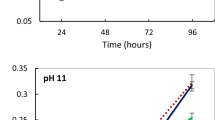Abstract
We have studied the dynamics of cylindrospermopsin concentration (CYN) of a benthic cyanobacterium of the genus Oscillatoria under various light conditions over the different growth phases. The present study is the first one reporting on the effect of abiotic factors on the CYN accumulation and release by a benthic species. In particular we have measured the concentrations of both intracellular and extracellular CYN. We found that the total CYN content is highest during the exponential growth phase at intermediate light level (10 μE m−2 s−1) and during the stationary growth phase at more extreme lower and higher light levels. Our results also indicate that the amount of the extracellular form varied between 56 % and 96 % of the total CYN concentrations. We found no relationship between CYN content and growth rates. These results suggest many similarities with planktonic species but also highlight some differences.


Similar content being viewed by others
References
Bar-Yosef Y, Sukenik A, Hadas O, Viner-Mozzini Y, Kaplan A (2010) Enslavement in the water body by toxic Aphanizomenon ovalisporum, inducing alkaline phosphatase in phytoplanktons. Curr Biol 20:1557–1561
Briand E, Bormans M, Quiblier C, Salençon MJ, Humbert JF (2012) Evidence of the cost of the production of Microcystins by Microcystis aeruginosa under differing light and nitrate environmental conditions. PlosOne 7(1):e29981
Brient L, Lengronne M, Bormans M, Fastner J (2008) First occurrence of cylindrospermopsin in freshwater in France. Environ Toxicol 24(4):415–420
Chiswell RK, Shaw GR, Eaglesham G, Smith MJ, Norris RL, Seawright AA, Moore MR (1999) Stability of cylindrospermopsin, the toxin from the cyanobacterium, Cylindrospermopsis raciborskii: effect of pH, temperature and sunlight on decomposition. Environ Toxicol 14:155–161
Cires S, Wörmer L, Timon J, Wiedner C, Quesada A (2011) Cylindrospermopsin production and release by the potentially invasive cyanobacterium Aphanizomenon ovalisporum under temperature and light gradients. Harmful Algae 10(6):668–675
Codd GA, Morrison LF, Metcalf JS (2005) Cyanobacterial toxins: risk management for health protection. Toxicol Appl Pharmacol 203:264–272
Dyble J, Tester PA, Litaker RW (2006) Effects of light intensity on cylindrospermopsin production in the cyanobacterial HAB species Cylindrospermopsis raciborskii. Afr J Mar Sci 28:309–312
Hawkins PR, Putt E, Falconer I, Humpage A (2001) Phenotypical variation in a toxic strain of the phytoplankter, Cylindrospermopsis raciborskii (Nostocales, Cyanophyceae) during batch culture. Environ Toxicol 16(6):480–487
Humpage AR, Falconer IR (2003) Oral toxicity of the cyanobacterial toxin cylindrospermopsin in male Swiss albino mice: determination of no observed adverse effect level for deriving a drinking water guideline value. Environ Toxicol 18(2):94–103
Kinnear S (2010) Cylindrospermopsin : a decade of progress on bioaccumulation research. Mar Drugs 8:542–564
Mazmouz R, Chapuis-Hugon F, Mann S, Pichon V, Méjean A, Ploux O (2010) Biosynthesis of cylindrospermopsin and 7-epicylindrospermopsin in Oscillatoria PCC 6506; Identification of the gene cluster and toxin analysis. Appl Environ Microbiol 76(15):4943–4949
Orr P, Jones G (1998) Relationship between microcystin production and cell division rates in nitrogen-limited Microcystis aeruginosa cultures. Limnol Oceanogr 43(7):1604–1614
Preußel K, Wessel G, Fastner J, Chorus I (2009) Response of cylindrospermopsin production and release in Aphanizomenon flos-aquae (cyanobacteria) to varying light and temperature conditions. Harmful Algae 8:645–650
Rücker J, Stüken A, Nixdorf B, Fastner J, Chorus I, Wiedner C (2007) Concentrations of particulate and dissolved cylindrospermopsin (CYN) in 21 Aphanizomenon dominated lakes of North East Germany. Toxicon 50:800–809
Saker ML, Griffith DJ (2000) Effects of temperature on growth and cylindrospermopsin content of seven isolates of C. raciborskii (Nostocales, Cyanophyceae) from water bodies in northern Australia. Phycologia 39:349–354
Saker ML, Neilan BA (2001) Varied diazotrophies, morphologies, and toxicities of genetically similar isolates of Cylindrospermopsis raciborskii (Nostocales, Cyanophyceae) from Northern Australia. Appl Environ Microbiol 67(4):1839–1845
Seifert M, McGregor G, Eaglesham G, Wickamasinghe W, Shaw G (2007) First evidence for the production of cylindrospermopsin and deoxy-cylyndrospermopsin by the freshwater benthic cyanobacterium, Lyngbia wollei (Fallow ex Gomont) Spezialeand Dick. Harmful Algae 6:73–80
Sinha R, Pearson LA, Davis TW, Burford MA, Orr PT, Neilan BA (2012) Increased incidence of Cylindrospermopsis raciborskii in temperate zones—Is climate change responsible? Water Res 46:1408–1419
Welker M, Bickel H, Fastner J (2002) HPLC-PDA detection of cylindrospermopsin—opportunities and limits. Water Res 36:4659–4663
Wiedner C, Visser PM, Fastner J, Metcalf JS, Codd GA, Mur LR (2003) Effects of light on the microcystin content of Microcystis strain PCC 7806. Applied Environ Microb 69:1475–1481
Wiedner C, Rücker J, Fastner J, Chorus I, Nixdorf B (2008) Seasonal dynamics of cylindrospermopsin and cyanobacteria in two German lakes. Toxicon 52:677–686
Wörmer L, Cires S, Carrasco D, Quesada A (2008) Cylindrospermopsin is not degraded by co-occurring natural bacterial communities during a 40-day study. Harmful Algae 7:206–213
Wörmer L, Huerta-Fontela M, Cires S, Carrasco D, Quesada A (2010) Natural photodegradation of the cyanobacterial toxins microcystin and cylindrospermopsin. Environ Sci Technol 44(8):3002–3007
Zhang X, Hu H, Men Y, Christoffersen KS (2010) The effect of Poterioochromonas abundance on production of intra and extracellular microcystin-LR concentration. Hydrobiologia 652:237–246
Acknowledgments
This work was financed by the National Agency for Security of Environment and Health (ANSES) through the TOXCYN Project. The experiment was run in the phytotronic chambers of the experimental facilities ECOLEX of ECOBIO.
Author information
Authors and Affiliations
Corresponding author
Rights and permissions
About this article
Cite this article
Bormans, M., Lengronne, M., Brient, L. et al. Cylindrospermopsin Accumulation and Release by the Benthic Cyanobacterium Oscillatoria sp. PCC 6506 under Different Light Conditions and Growth Phases. Bull Environ Contam Toxicol 92, 243–247 (2014). https://doi.org/10.1007/s00128-013-1144-y
Received:
Accepted:
Published:
Issue Date:
DOI: https://doi.org/10.1007/s00128-013-1144-y




